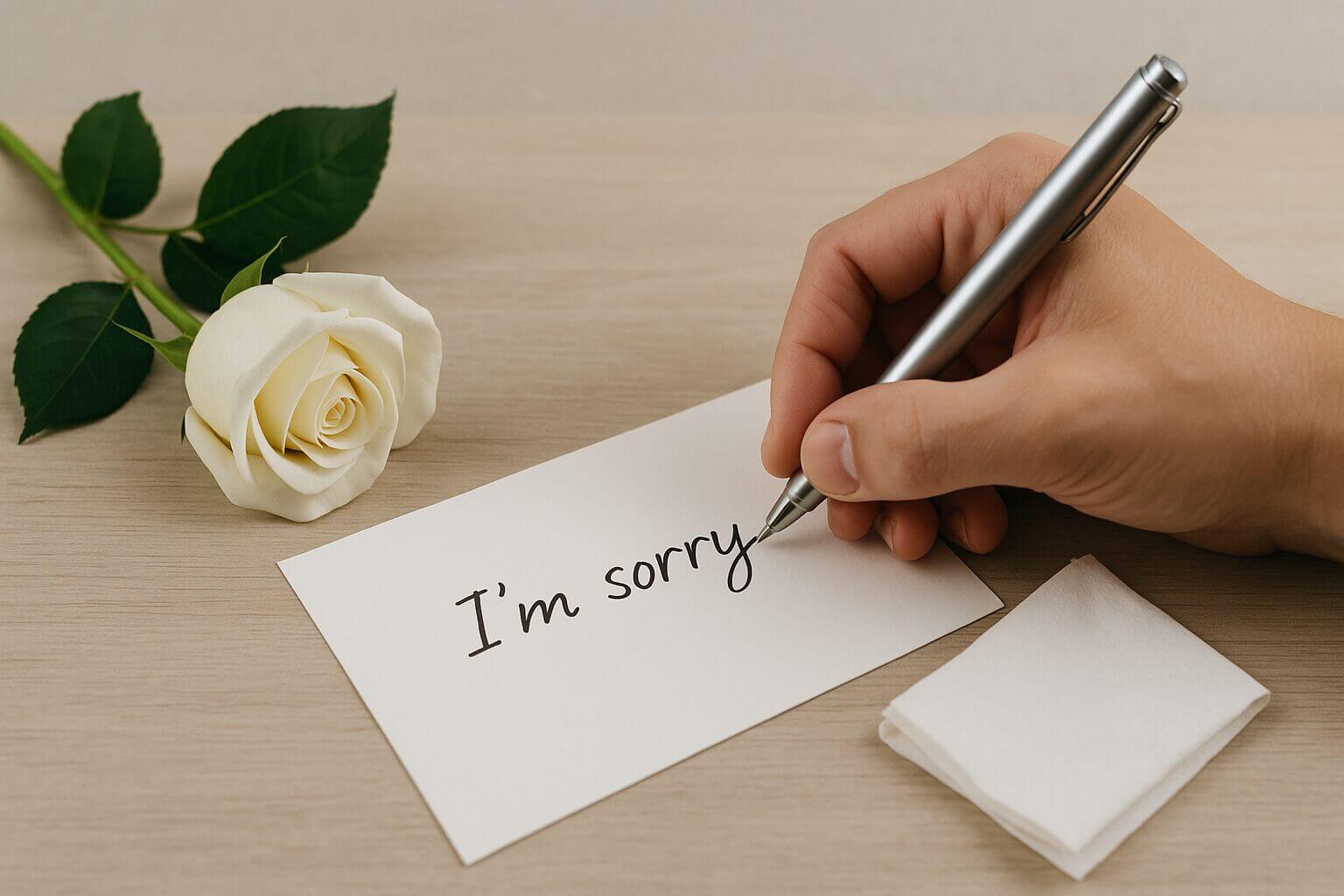The Importance and Impact of Effective Apology Letters
Writing an apology letter demonstrates accountability and shows genuine commitment to repairing relationships. A well-crafted apology can transform negative experiences into opportunities for growth and stronger connections.
Why Written Apologies Matter
- Written apologies provide a permanent record of your remorse
- They allow the recipient time to process your words without pressure
- Letters give you space to fully explain your perspective and solutions
- Written format helps you organize thoughts more clearly than verbal apologies
The Psychology of Effective Apologies
- Genuine apologies activate empathy in both the writer and recipient
- Research shows apologies can be twice as effective as simply offering compensation
- According to Zendesk statistics, 45% of customer experience leaders believe apologies significantly impact loyalty
- Properly structured apologies address both logical and emotional aspects of conflict
Statistics Showing the Power of Apologies
- 70% of complaining customers return if their issue is resolved favorably
- 62% of Americans believe excessive apologies diminish sincere ones
- Prompt resolution of complaints often leads to increased customer loyalty
- Companies with effective apology strategies maintain higher satisfaction ratings
Essential Steps to Write a Sincere Apology Letter
Creating an effective apology letter requires following specific steps that ensure your message conveys genuine remorse and commitment to improvement.
Acknowledge Your Mistake Clearly
- State exactly what you did wrong without vague language
- Mention specific incidents, dates, and actions that caused harm
- Demonstrate understanding of the consequences of your actions
- Avoid minimizing the impact of your mistake
Example: “I need to acknowledge that I was responsible for sending you incorrect flight information for your business trip on May 15th. I understand this caused you to miss your flight and created unnecessary stress during an important time.”
Express Genuine Remorse
- Use direct language like “I’m sorry” or “I apologize”
- Avoid conditional phrases like “I’m sorry if you felt hurt”
- Express how you felt when you realized your mistake
- Show empathy for how the recipient might have felt
Example: “I sincerely apologize for forgetting to send the marketing report you requested. I felt awful when I heard you had to reschedule your meeting because of my negligence.”
Offer Solutions and Request Forgiveness
- Outline specific steps you’ll take to fix the problem
- Explain how you’ll prevent similar issues in the future
- Make reasonable offers of compensation when appropriate
- Directly ask for forgiveness in a humble manner
Example: “I’ve already contacted the regional manager to explain that I’m at fault. Moving forward, I’ll implement a double-check system for all client communications. I hope you can forgive this error and that we can continue our professional relationship.”
Types of Apology Letters for Different Situations
Different circumstances require different approaches to apology letters. Adapting your letter to the specific situation ensures it resonates with the recipient.
Personal Apology Letters
- Focus on emotional impact and relationship repair
- Include shared history and personal connection points
- Use warmer, more intimate language while maintaining sincerity
- Address how you plan to rebuild trust over time
Example formats:
- Letters to friends after misunderstandings
- Family apologies after heated arguments
- Relationship apologies for breaking trust
- Social gathering mistake apologies
Professional Workplace Apologies
- Maintain appropriate professional tone
- Focus on concrete impacts to work processes or outcomes
- Include specific commitment to professional improvement
- Reference relevant workplace standards or expectations
Example formats:
- Colleague apology for missed deadlines
- Manager apology for miscommunication
- Team apology for project errors
- Workplace behavior apology letters
Business Customer Apology Letters
- Acknowledge business impact of your mistake
- Present clear action plan for resolution
- Include appropriate compensation when applicable
- Reinforce commitment to quality service
Example formats:
- Service failure apology emails
- Product defect apology letters
- Shipping delay apology messages
- Billing error correction letters
Best Practices and Format for Apology Letters
Following proper format and structure ensures your apology letter communicates effectively and professionally.
Structure and Components
- Clear salutation: Address the recipient by name
- Purpose statement: Identify your letter as an apology upfront
- Mistake acknowledgment: Clearly state what went wrong
- Impact recognition: Show understanding of consequences
- Genuine apology: Express sincere remorse
- Solution proposal: Outline how you’ll fix the issue
- Commitment to change: Explain prevention measures
- Request for forgiveness: Ask humbly for another chance
- Appropriate closing: End with respectful closing phrase
Appropriate Language and Tone
- Be direct: Use clear, straightforward language
- Stay specific: Avoid vague or general statements
- Show sincerity: Use authentic, non-defensive phrasing
- Remain humble: Avoid excuses or blame-shifting
- Be concise: Keep your apology focused and to the point
Phrases to use:
- “I take full responsibility for…”
- “I understand that my actions caused…”
- “I sincerely regret that I…”
- “I am committed to ensuring this doesn’t happen again by…”
Delivery Methods for Maximum Impact
- Email: Quick delivery for time-sensitive issues
- Handwritten letter: Shows extra effort for personal apologies
- Formal business letter: Best for professional situations
- In-person delivery: Demonstrates courage and sincerity
- Timing considerations: Deliver promptly but not hastily
Common Mistakes to Avoid in Apology Letters
Understanding what not to do is just as important as knowing what to include in your apology letter.
Phrases That Weaken Your Apology
- Conditional language: “I’m sorry if you were offended”
- Blame-shifting: “I apologize, but if you had told me earlier…”
- Minimizing: “I’m sorry for the small oversight”
- Generalizing: “I apologize for anything I might have done”
Instead, use:
- “I apologize for my inconsiderate behavior”
- “I take full responsibility for missing the deadline”
- “I’m sorry for the significant problems this caused”
- “I apologize specifically for forgetting to send the report”
Timing and Delivery Issues
- Waiting too long to apologize increases resentment
- Rushing an apology before understanding the full impact
- Choosing inappropriate communication channels
- Delivering apologies in public when privacy is needed
Avoiding Non-Apologies and Justifications
- Explanations that sound like excuses
- Focusing more on your intentions than the impact
- Including “but” statements that negate your apology
- Asking for understanding before expressing remorse
Example of a non-apology: “I’m sorry you felt that way, but I was really busy with other priorities.”
Better alternative: “I apologize for missing our meeting. My busy schedule is not an excuse, and I should have prioritized our appointment.”
Effective Apology Letter Templates and Examples
Use these templates as starting points for crafting your own personalized apology letters.
Personal Apology Letter Template
textDear [Name],
I'm writing to apologize sincerely for [specific action]. I understand that my behavior caused [specific impact] and hurt you. This was never my intention, but I take full responsibility for my actions.
I feel terrible about what happened and want you to know how deeply I regret [mistake]. Our relationship is important to me, and I would never want to damage the trust between us.
Moving forward, I plan to [specific action steps]. I hope you can forgive me, though I understand if you need time.
Sincerely,
[Your Name]
Professional Apology Letter Template
textDear [Recipient's Name],
I'm writing to apologize for [specific error or incident] that occurred on [date]. I understand this caused [specific consequences] and created difficulties for you and the team.
I sincerely regret this mistake and take full responsibility for the error. This does not reflect the professional standards I hold myself to, and I am committed to ensuring it doesn't happen again.
To address this issue, I have already [immediate action taken] and plan to [future preventative measures]. Please let me know if there's anything else I can do to rectify this situation.
I value our professional relationship and hope we can move forward from this incident.
Regards,
[Your Name]
[Position]
Customer Apology Letter Template
textDear [Customer Name],
On behalf of [Company Name], I sincerely apologize for [specific issue] you experienced on [date]. We understand this [describe impact on customer] and failed to meet the high standards we set for ourselves.
We take this matter seriously and have already [immediate action taken]. Additionally, we are implementing [long-term solution] to ensure this doesn't happen again.
As a token of our appreciation for your patience and understanding, we would like to offer [appropriate compensation or gesture].
Your satisfaction is our priority, and we value your continued business. If you have any questions or concerns, please contact me directly at [contact information].
Sincerely,
[Your Name]
[Position]
[Company Name]
Frequently Asked Questions About Apology Letters
What are the three main parts of an effective apology letter?
The three essential components of any apology letter are:
- Acknowledgment of wrongdoing: Clearly stating what you did wrong
- Expression of genuine remorse: Sincerely apologizing without excuses
- Commitment to resolution: Explaining how you’ll fix the problem and prevent recurrence
Additional elements that strengthen apologies include recognizing the impact of your actions and directly requesting forgiveness.
How do you apologize professionally in a letter?
To apologize professionally:
- Use formal business letter format with proper salutation and closing
- State the purpose of your letter immediately
- Be specific about the incident without oversharing irrelevant details
- Accept responsibility without blaming others or circumstances
- Maintain appropriate professional language throughout
- Focus on concrete solutions rather than emotional expressions
- Keep the letter concise and focused on the issue at hand
- Follow up appropriately after sending the letter
How do you start an apology letter?
Effective ways to start an apology letter include:
- Direct statement: “I’m writing to apologize for…”
- Acknowledgment: “I recognize that my actions on [date]…”
- Purpose statement: “Please accept this letter as my sincere apology for…”
- Expression of regret: “I deeply regret my behavior regarding…”
Avoid starting with justifications, excuses, or vague statements that dilute your message.
How long should an apology letter be?
An effective apology letter should be:
- Personal apologies: 1-2 paragraphs (200-300 words)
- Professional apologies: 3-4 paragraphs (300-400 words)
- Business/customer apologies: 4-5 paragraphs (400-500 words)
Focus on quality over quantity. A sincere, specific, and concise apology is more effective than a lengthy, rambling one. Include enough detail to show understanding of the situation without becoming excessive.
What should you not include in an apology letter?
Elements to avoid in your apology letter:
- Conditional language (“I’m sorry if…”)
- Blame-shifting phrases (“I apologize, but you also…”)
- Minimizing statements (“It wasn’t that serious…”)
- Excessive excuses or justifications
- Requests for sympathy or understanding
- Inappropriate humor or casual tone
- Promises you cannot keep
- Vague or general apologies without specifics
How do you write a heartfelt apology letter?
To write a truly heartfelt apology:
- Reflect deeply on your actions before writing
- Use authentic language that sounds like your natural voice
- Include specific details about what happened
- Express how you felt when you realized your mistake
- Acknowledge how the other person might have felt
- Share what you’ve learned from the experience
- Make meaningful offers to make amends
- Write from the heart rather than following a template exactly
- Consider handwriting the letter for personal touch
Conclusion: Taking Action with Your Apology Letter
Writing an effective apology letter requires honesty, empathy, and a commitment to improvement. By following the structure and guidelines in this guide, you can create apologies that repair relationships and demonstrate your integrity.
Remember that the most powerful apology combines sincere words with meaningful actions. After sending your letter, follow through on your commitments and give the recipient space to process their feelings.
Ready to repair a relationship? Start by identifying exactly what went wrong, take full responsibility, and craft your apology letter today using the templates and guidance provided. Your sincere effort to make amends can transform a mistake into an opportunity for growth and stronger connections.





